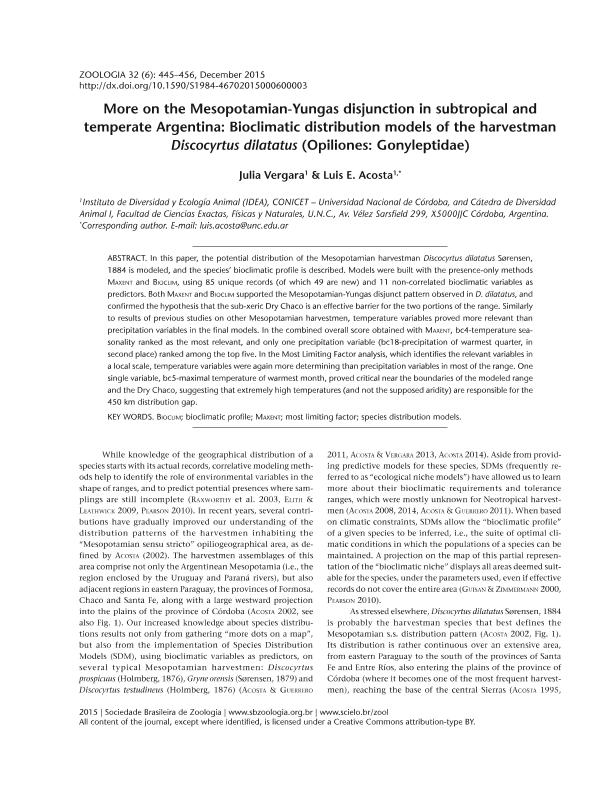Mostrar el registro sencillo del ítem
dc.contributor.author
Vergara Oficialdegui, Julia

dc.contributor.author
Acosta, Luis Eduardo

dc.date.available
2016-11-03T16:01:37Z
dc.date.issued
2015-12
dc.identifier.citation
Vergara Oficialdegui, Julia; Acosta, Luis Eduardo; More on the Mesopotamian-Yungas disjunction in subtropical and temperate Argentina: Bioclimatic distribution models of the harvestman Discocyrtus dilatatus (Opiliones, Gonyleptidae); Soc Brasileira Zoologia; Zoologia (curitiba); 32; 6; 12-2015; 445-456
dc.identifier.issn
1984-4670
dc.identifier.uri
http://hdl.handle.net/11336/7935
dc.description.abstract
In this paper, the potential distribution of the Mesopotamian harvestman Discocyrtus dilatatus Sørensen, 1884 (Opiliones, Gonyleptidae) is modeled, and the species bioclimatic profile is described. Models were built with the presence-only methods MAXENT and BIOCLIM, using 85 unique records (of which 49 are new) and 11 non correlated bioclimatic variables as predictors. Both MAXENT and BIOCLIM supported the Mesopotamian-Yungas disjunct pattern observed in D. dilatatus, as well as confirmed the role of the sub-xeric Dry Chaco as an effective barrier for the two portions of the range. Like in other Mesopotamian harvestmen, temperature variables proved more relevant than precipitation ones in the final models. In the combined overall score obtained with MAXENT, bc4-temperature seasonality ranked as the most relevant, and only one precipitation variable (bc18- precipitation of warmest quarter, in second place) ranked among the top five. In the Most Limiting Factor analysis, which identifies the relevant variables in a local scale, temperature variables demonstrated again being more determining than precipitation ones on most of the range. One single variable, bc5-maximal temperature of warmest month proved critical on the boundaries of the modeled range and the Dry Chaco, suggesting that extremely high temperatures (and not the supposed aridity) are responsible for the 450 km distribution gap.
dc.format
application/pdf
dc.language.iso
eng
dc.publisher
Soc Brasileira Zoologia

dc.rights
info:eu-repo/semantics/openAccess
dc.rights.uri
https://creativecommons.org/licenses/by-nc-sa/2.5/ar/
dc.subject
Bioclim
dc.subject
Bioclimatic Profile
dc.subject
Maxent
dc.subject
Most Limiting Factor
dc.subject
Species Distribution Models
dc.subject.classification
Zoología, Ornitología, Entomología, Etología

dc.subject.classification
Ciencias Biológicas

dc.subject.classification
CIENCIAS NATURALES Y EXACTAS

dc.title
More on the Mesopotamian-Yungas disjunction in subtropical and temperate Argentina: Bioclimatic distribution models of the harvestman Discocyrtus dilatatus (Opiliones, Gonyleptidae)
dc.type
info:eu-repo/semantics/article
dc.type
info:ar-repo/semantics/artículo
dc.type
info:eu-repo/semantics/publishedVersion
dc.date.updated
2016-11-02T18:15:30Z
dc.identifier.eissn
1984-4689
dc.journal.volume
32
dc.journal.number
6
dc.journal.pagination
445-456
dc.journal.pais
Brasil

dc.journal.ciudad
Curitiba
dc.description.fil
Fil: Vergara Oficialdegui, Julia. Consejo Nacional de Investigaciones Cientificas y Tecnicas. Centro Cientifico Tecnologico Cordoba. Instituto de Diversidad y Ecologia Animal; Argentina
dc.description.fil
Fil: Acosta, Luis Eduardo. Consejo Nacional de Investigaciones Cientificas y Tecnicas. Centro Cientifico Tecnologico Cordoba. Instituto de Diversidad y Ecologia Animal; Argentina
dc.journal.title
Zoologia (curitiba)

dc.relation.alternativeid
info:eu-repo/semantics/altIdentifier/url/http://ref.scielo.org/j4h3pj
dc.relation.alternativeid
info:eu-repo/semantics/altIdentifier/doi/http://dx.doi.org/10.1590/S1984-46702015000600003
Archivos asociados
